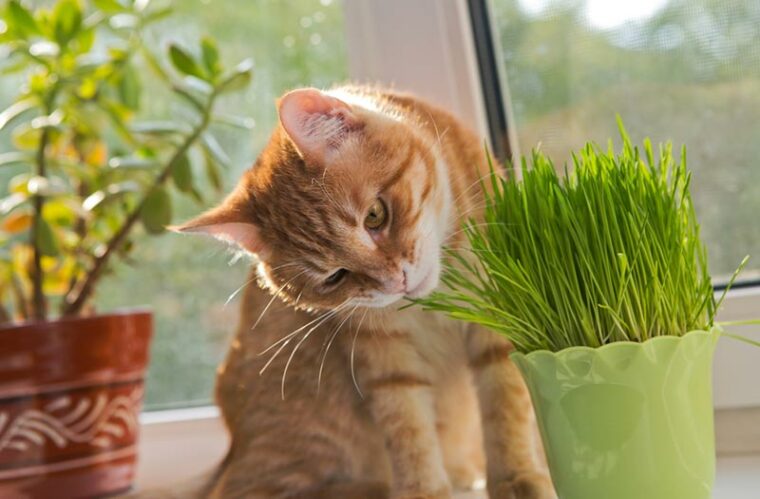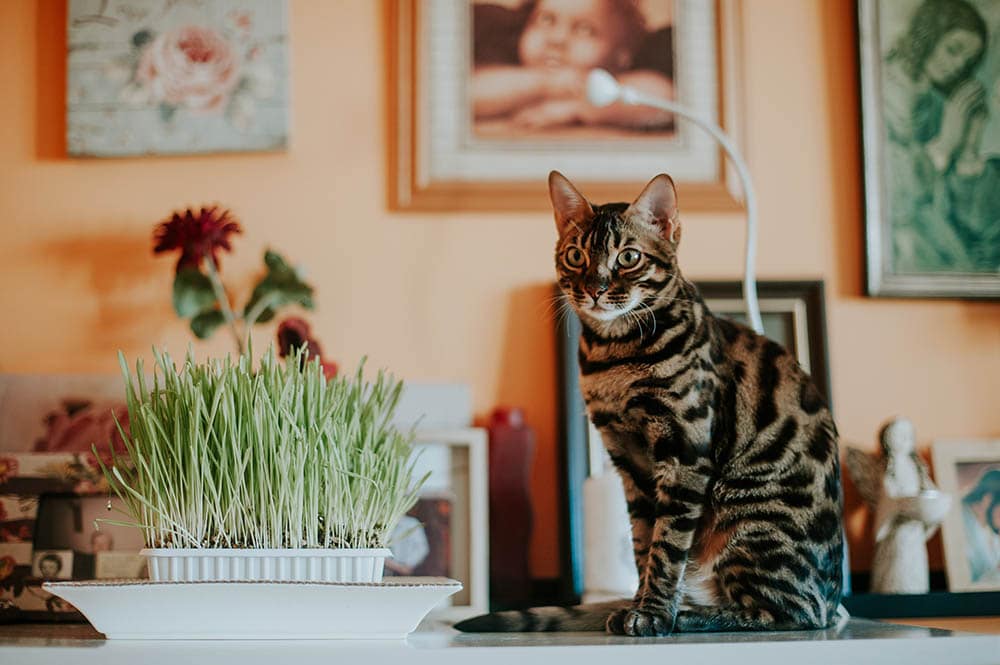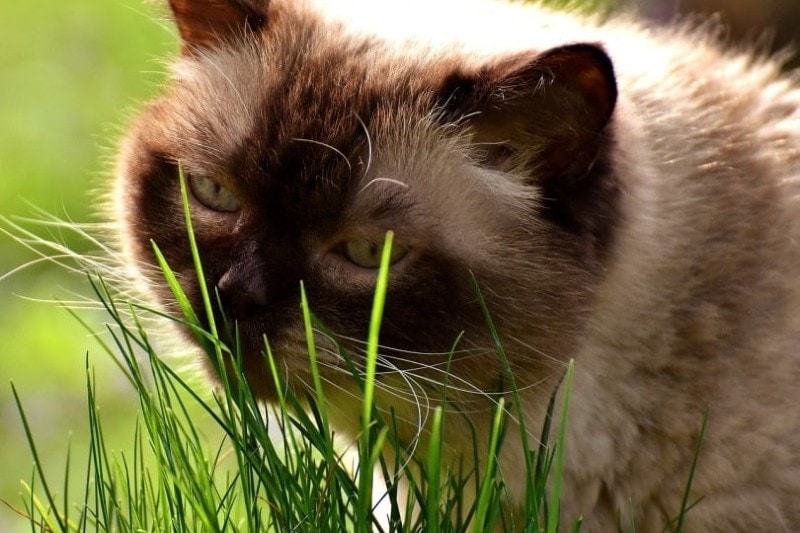
Cats are carnivores; they prefer meat over everything else and don’t really need carbs, fruits, or vegetables in their diet. However, they do have a soft side for a specific type of grass. You’ve probably already caught your feline once or twice snacking on some greens. Or maybe you already know about its benefits and include cat grass in your pet’s diet.
In any case, there are quite a few cat grass varieties out there, and they all have perks for our furballs. So, which grass type will be best for your cat? How do you grow it manually? Today, we’ll cover five grass types and their pros, learn how to cultivate them and share essential care tips. Here goes!!
What Is Cat Grass?
Often mistaken for catnip or mint, cat grass (sometimes called “pet grass”) is NOT the same thing. Instead, it’s a collective term that’s used to describe a short range of grass types that are (relatively) easy to grow for the average pet owner. They are beneficial for cats and one of the theories why cats love grass is that it helps their digestive systems work better and aids in getting rid of intestinal parasites.1 Low-maintenance, cheap, and highly accessible, cat grass is any feline parent’s best friend.
You won’t need to have a backyard or a garden to cultivate it: cat grass is well-suited for indoor environments and is quick to grow. All you have to do is get the seeds (barley, rye, oat, orchard, or wheat), create the right conditions, and take proper care of the grass while it sprouts. Also, don’t forget to water, trim, and resow the grass. Let’s talk about that in more detail next. You may try a few grass types, and see which one your cat picks as the tastiest option.
The 5 Types of Cat Grass
1. Oat Grass

Looking for pet grass with the best flavor? Consider oat grass. Of course, whether this is actually the tastiest grass for most cats, we don’t know, and this is just anecdotal. But your cat will be the judge of it. It’s rich in soluble fiber, meaning the cat’s digestive system will be thankful for chewing on this grass. Add a healthy dose of protein-rich cat food and other nutritional elements, and you’ll get an all-around solid, beneficial snack for the feline.
2. Barley Grass

Cats might not have a sweet tooth, but they still may enjoy the flavor of barley grass. Plus, just like oat grass, it doesn’t just taste good; Thanks to the high concentration of fibers, this grass may have a strong laxative effect. Barley is rich in nutrients, and vitamins, too, and will serve as an extra source of soluble fiber for your fluffy family member. It grows up to 17 inches tall.
3. Ryegrass

Cat grass has a very short lifespan, depending on the temperature, humidity levels, and sun exposure, may only last for 1–3 weeks after reaching full height. Ryegrass is the longest-lasting and most durable of all the cat grasses, though. Thus, if you’re looking for a variety that will stay fresh and healthy for a bit longer, this grass will be a better pick.
4. Wheatgrass

Feline parents in the market for the most beneficial pet grass should go with wheatgrass. It packs more vitamins and minerals than any of the other types and contains around 1.9% of chlorophyll. Most cats enjoy it, too, as it’s not too sweet or sour. Humans like wheatgrass as well: some folks add it to their smoothies for that extra “kick”.
5. Orchard Grass

This one’s not as popular as the other four, but it’s still worth your furry friend’s attention. It’s often also mixed with the other types of grass and sold under the joint name of cat grass. Orchard grass is a cool-season perennial plant (not annual) that’s often used as hay grass. Plus, some domestic cats find it delicious (although they don’t have sweet taste receptors), and the grass often doesn’t have any diseases or bug problems. Do keep in mind that it’s also quite tall. The leaves reach 12 inches in height, but the grass may grow even higher under well irrigated conditions.
How to Grow Cat Grass: Essential Tips
Start by investing in a large container and filling it 2/3 of the way with organic potting soil. Next, sow the seeds (1/4 inch deep), top them up with soil, and add some water (50 ml). When planting in rows, there should be a 1-inch gap between the seeds, or you can just sprinkle them evenly. Now, cat grass does, indeed, thrive indoors. Still, for the best results, plant it outdoors in mid-spring (right after frost; don’t plant while the ground is still frozen).
To stimulate growth, cover the container loosely with plastic wrap (not too tightly); remove it in 3–7 days. Put the pot in a warm place outside of direct sunlight, and make sure the soil is moist (but don’t overwater it). Give the seeds 2–3 days, and you should see them sprouting. As for the sun, 2–3 hours of sunlight should be enough; direct exposure might burn the seeds, though. When growing indoors, place the pot close to a south-facing window.
Caring for Cat Grass
When Will It Be Ready for the Cat?
On average, it takes a couple of weeks for cat grass to grow. Yes, it’s really fast! Once the grass reaches 4–6 inches in height, that means the kitty can feast on it. So, keep an eye on it. This is important: while the grass is still developing, keep the cats away from it. Otherwise, they will devour it quickly and you’ll have to start over.

Should You Mix Different Cat Grass Types?
Cats like diversity in their food. So, to turn the grass into a more delicious snack, it would be best to plant different varieties in the same container. You can even sow the seeds of all five pet grass types in one pot! Or plant the seeds in different planters but put them in the same room or even in the same corner. This way, the cat will have more than one grass on the menu.
But wait, will the feline see the difference? Yes, they certainly will! After a while, you might start noticing that they’re favoring one of the grass types over the rest (this doesn’t always happen, though). If that’s the case with your cat, you can get rid of the rest. Consult with a veterinarian about the safest and most appropriate grass types for your cat.
Why Do Cats Like This Grass?
Cat grass is an annual edible plant (for both felines and humans). If you’re looking for new ways to enrich your cat’s diet with extra fiber, cat grass will be a great choice. But still, why are kitties fond of it? What’s so special about this grass that makes it stand out? There are a few theories we will discuss, with currently one possible scientific explanation.

Is It Safe for Felines to Eat Cat Grass?
Yes, cat grass is safe for kitties to nibble on. In contrast to catnip, which might cause mild tolerance over time, this grass doesn’t affect the pet’s “happiness” receptors or make them aggressive. Therefore, your cat won’t eat too much of it and make its own tummy hurt. Our furry buds usually know exactly how much cat grass they need to eat. But, as a general rule, it shouldn’t make up more than 10% of their daily diet.
That said, before introducing your fluffy friend to cat grass, talk to a vet. True, wheat, oat, and all the other pet grass types are safe. But the nutritional needs of every pet animal are different. And one more thing: there is no need to mix the grass with wet or dry food. It’s best to just place the container in an accessible area and let the cat decide when to eat it. Just make sure the feline can’t push it down!
On the other hand, eating grass outside should be avoided, as it may be harmful if it has been treated with pesticides.
My Cat Is Spitting Up the Grass: Is It Okay?
One of the biggest presumed benefits of cat grass is that it helps felines get rid of swallowed hairballs. So, if the cat is occasionally spitting out some grass followed by hairballs, there’s nothing to worry about, as it’s completely natural. In contrast, if this is a common occurrence, your cat continues vomiting, drooling, is off their food, or you see blood in the vomit or coming out of the pet’s mouth, take them to a vet for a prompt check (or, at the very least, get in contact with them).
Sometimes, when a cat eats the grass too quickly or swallows a long piece, a blade of grass can get stuck at the back of their throat, behind the soft palate. That’s when the cat will start to drool, retch, gag, swallow exaggeratedly, sneeze, go off their food, or vomit. Other signs include constant swallowing and a bad smell from the feline’s mouth/nose, sometimes with discharge. You won’t be able to see that grass blade in your cat’s mouth, as it’s hidden behind the soft palate! Let a veterinarian handle that instead. They’ll sedate the cat and only then get the job done. Otherwise, this will continue to cause irritation, inflammation and infection at the back of the throat, alongside pain, and may lead to an abscess formation if left untreated.
Grass is not digestible in cats, so eating excessive amounts of grass at once is not a good idea and can lead to a blockage of the stomach and intestines that exhibits as vomiting, so it’s another reason to get your kitty checked by a vet.

What Will Happen to Other Plants in the House?
After you introduce pet grass, the feline will, most likely, leave the rest of your plants alone. However, on the other hand, some cats may actually become more interested in other house plants. Now, while kitties deserve all the best in the world, they still need supervision. Otherwise, they might ingest a toxic plant or damage a beautiful flower that you’ve been growing for years by chewing on it! Thankfully, when there’s enough pet grass in the house, the chances of your cat shifting their focus to other plants will be low.
You should still remove any flowers/plants that are toxic for cats from the house. We’re talking about lilies, figs, jade plants, and eucalyptus, to name a few. These can be quite dangerous for your cat, and in the case of lilies, lead to irreversible and sometimes fatal kidney damage. Sometimes, cat grass has the opposite effect: instead of avoiding other plants, cats decide to taste them all as well. So, be very careful!
Conclusion
To keep your cat happy, you can help them in caring for their digestive system and maintain their instinctual behavior of chomping on grass. And no, feeding them premium-quality food and offering fresh water won’t always cut it. Sometimes, cats will still swallow something they weren’t supposed to and may need to be checked by the vet. In other cases, such as the occasional hairball, they will benefit from the fibers for laxative effect. Cat grass has nutritional value, too.
It’s a low-calorie, yet nutrient-rich snack that tastes and feels good for a kitty to chew on. The best thing about it—there’s nothing hard about cultivating oat, barley, wheat, orchard, or ryegrass. You can grow it indoors so that the furball has access to it 24/7. Just make sure to follow our tips!
Featured Image Credit: Okssi, Shutterstock








